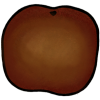Maturity and Quality
Change in color is the main maturity index for Chinese jujube (Zizyphus jujuba). If picked green they do not ripen satisfactorily off the tree. Color changes from green to whitish-green to reddish-brown to dark-brown as the jujubes ripen. They should not be picked before the whitish-green stage.
Jujubes are round to oblong drupes (2-5 cm in diameter, depending on cultivar) and have a spongy, subacid and sweet-tasting pulp. They can be eaten fresh, dried, or candied and are a very rich source of vitamin C. Compared with other fruits fresh jujubes are lower in water content (70-75%) and titratable acidity (0.15-0.25%), but higher in soluble solids (21-23%), total sugars (20-22%), phenolics (0.2-0.3%), and ascorbic acid (400-600mg/100g fresh weight).
Postharvest Handling and Storage
3-10°C (38-50°F) for fresh jujubes (storage potential = 2-3 months)
3-20°C (38-68°F) for dried jujubes (can be stored for up to one year)
15-20ml CO2/kg·hr at 20°C (68°F); nonclimacteric respiratory pattern
To calculate heat production multiply ml CO2 /kg·hr by 440 to get Btu/ton/day or by 122 to get kcal/metric ton/day.
Exposure of fresh whitish-green jujubes to 100ppm ethylene for 2-4 days at 20°C (68°F) results in faster and more uniform ripening as indicated by change of color to reddish-brown.
Disorders
Chilling injury. Fresh jujubes are susceptible to chilling injury (development of sheet pitting, i.e. relatively large sunken areas, on the surface) if kept at temperatures below 3°C (38°F) for longer than two weeks.
Jujubes can be infected with decay-causing fungi (such as Alternaria spp and Botrytis spp.) If they are stressed due to physical damage and/or chilling injury. The best control strategies are avoiding mechanical injuries during harvesting and handling and maintaining the optimum ranges of temperature and relative humidity throughout the postharvest handling system.






